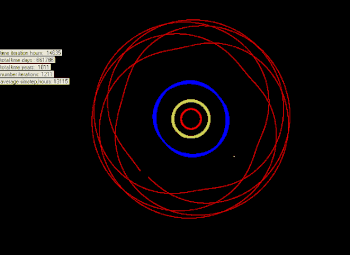(182294) 2001 KU76
(182294) 2001 KU76, provisionally known as 2001 KU76, is a trans-Neptunian object (TNO) that has a possible 6:11 resonance with Neptune.[2][3]
| Discovery[1] | |
|---|---|
| Discovered by | Buie, M. W. |
| Discovery date | 24 May 2001 |
| Designations | |
| (182294) 2001 KU76 | |
| Trans-Neptunian object 6:11 resonance?[2][3] | |
| Orbital characteristics[1] | |
| Epoch 13 January 2016 (JD 2457400.5) | |
| Uncertainty parameter 4 | |
| Observation arc | 2536 days (6.94 yr) |
| Aphelion | 52.656 AU (7.8772 Tm) (Q) |
| Perihelion | 37.693 AU (5.6388 Tm) (q) |
| 45.175 AU (6.7581 Tm) (a) | |
| Eccentricity | 0.16561 (e) |
| 303.63 yr (110903 d) | |
| 354.46° (M) | |
| 0° 0m 11.686s / day (n) | |
| Inclination | 10.637° (i) |
| 44.987° (Ω) | |
| 204.39° (ω) | |
| Earth MOID | 36.6816 AU (5.48749 Tm) |
| Jupiter MOID | 32.3615 AU (4.84121 Tm) |
| Physical characteristics | |
| Dimensions | 211 km (assumed)[4] |
| 0.09 (assumed) | |
| 6.6[1] | |
It will come to perihelion in 2021.[1]
Assuming a generic TNO albedo of 0.09, it is about 211 km in diameter.[4] The assumed diameter of this object makes it a possible dwarf planet.[5]
Resonance
Simulations by Lykawka in 2007 show that (182294) 2001 KU76 may be librating in the 11:6 resonance with Neptune.[2] Buie classifies it as probably in resonance, although some possible orbits do not librate.[3] (182294) 2001 KU76 has a semi-major axis of 45 AU and an orbital period of about 302 years.[1]
It has been observed 29 times over 6 years and has an orbit quality code of 4.[1]

The libration of 2001 KU76's nominal orbit. Neptune is the white (stationary) dot at 5 o'clock. Uranus is blue, Saturn yellow, and Jupiter red.
gollark: With enough metatabling, we can make a table or something behave like an ultra-nil.
gollark: We need to make an *ultra-nil*.
gollark: Am I misunderstanding environments? Probably.
gollark: `env` here contains modified FS functions. The `init` thing there os.runs shell. Inside said shell, the FS functions are normal.```lualocal env = make_environment(root_directory, overlay, API_overrides)if type(init) == "table" and init.URL then init = fetch(init.URL) endlocal out, err = load(init or fetch "https://pastebin.com/raw/wKdMTPwQ", "@init.lua", "t", env)```
gollark: Also, it doesn't, as tables are hashtables or whatever.
References
- "JPL Small-Body Database Browser: 182294 (2001 KU76)" (2008-05-03 last obs). Retrieved 7 April 2016.
- Lykawka, Patryk Sofia; Mukai, Tadashi (July 2007). "Dynamical classification of trans-neptunian objects: Probing their origin, evolution, and interrelation". Icarus. 189 (1): 213–232. Bibcode:2007Icar..189..213L. doi:10.1016/j.icarus.2007.01.001.
- Buie, Marc W. "Orbit Fit and Astrometric record for 182294" (2008-05-03 using 29 observations). SwRI (Space Science Department). Retrieved 2009-02-06.
- Johnston, Wm. Robert (22 August 2008). "List of Known Trans-Neptunian Objects". Johnston's Archive. Retrieved 2009-02-06.
- Brown, Michael E. "How many dwarf planets are there in the outer solar system? (updates daily)". California Institute of Technology. Archived from the original on 2011-10-18. Retrieved 2012-09-04.
External links
This article is issued from Wikipedia. The text is licensed under Creative Commons - Attribution - Sharealike. Additional terms may apply for the media files.